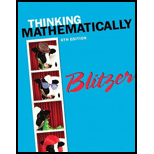
Ambassadors from countries A, B, C, D, E, and F are to be seated around a circular conference table. Friendly relations among the various countries are described as follows: A has friendly relations with B and F. B has friendly relations with A, C, and E. C has friendly relations with B, D, E, and F. E has friendly relations with B, C, D, and F. All friendly relations are mutual. Using vertices to represent countries and edges to represent friendly relations, draw a graph that models the information given. Then use a Hamilton circuit to devise a seating arrangement around the table so that the ambassadors from B and E are seated next to each other, and each ambassador represents a country that has friendly relations with the countries represented by the ambassadors next to him or her.
Want to see the full answer?
Check out a sample textbook solution
Chapter 14 Solutions
Thinking Mathematically (6th Edition)
- 1. Please look at the picture carefully and find the answer from multiple choice.arrow_forwardLet a graph have vertices S, T, U, V, W, X, Y and edge set {{S, V}, {S, X}, {U, W}, {U,X}, {V,X},{V,Y}, {X, Y}} a. What is the degree of vertex W ? b. What is the degree of vertex U? c. How many components does the graph have?arrow_forwardThe floor plan of a five-room house is shown. The rooms are labeled A, B, C, D, and E. The outside of the house is labeled F. The openings represent doors. Use the floor plan to answer the questions below. A B E a. Draw a graph that models the connecting relationships in each floor plan. Use vertices to represent the rooms and the outside, and edges to represent the connecting doors. Choose the correct answer below. A F А C В A D В E D В B D E D E F Yes - a path exists No such path exists DA BFCE Drag the correct answer into the target below, then, if a path exists, drag the vertex labels to the appropriate locations in the path. b. Use your graph to determine if it is possible to find a path that uses each door only once. c. If such a path exists, find one. If a path exists, it goes from F to B to E to to to to toarrow_forward
- Where are the vertices?arrow_forwardFind All vertices that are adjacent to v1. O v4 O v2, v1, v3 V5 O e1,e2, e7 O v5, v2 O e6 v1, v2, v3, v5 e 1 VI es e2 e5 • V4 e7 e 3. V2 e6 V3arrow_forward3.) The graph below represents the chocolate consumed by people. a.) What is the constant of proportionality? 30 24 18 12 6 3 6. Реople 12 15 b.) What does the point (9,18) represent? Chocolatesarrow_forward
- In a park, Camila is creating two designs for a fenced-in region so that dogs have a safe place to play. Camila designs each region using a coordinate grid where each unit on the grid represents one foot. Part A Camila’s first design is triangular-shaped. On the coordinate grid, she identifies two of the vertices to be (0, 0) and (0, 35). The third vertex is labeled as (x, 42). What is the positive x-coordinate of the third vertex if the area of the region will cover 700 square feet? Part B Camila’s second design is a six-sided region using the coordinates (0, 0), (0, 35), (30, 0), (40, 48), (35, 48), and (5, 35). How many feet of fencing material will Camila need for this region (rounded to the nearest whole number) ?arrow_forwardDiscrete matharrow_forwardG2. Draw a graph with the set of vertices V = {a, b, c, d} and the set of edges E= {{b, c), {c, d), (a, d}}. Find the degree of vertex a.arrow_forward
- If A (-2,-1),B(a,0),C(4,5) and D(1,2 )are the vertices of a parallelogram, find the values of a and b.arrow_forwardQ14A. Consider the graph with the following vertices and edges: V = {a, b, c, d, e, f} E = {{a, b}, {a, c}, {a, d}, {a, f}, {b, c}, {b, f}, {c, d}, {c, f}, {d, e}, {d, f} Which of the following sets of edges represent subgraphs of the graph that are trees? (Select all that apply.) Question 14 options: {{a, b}, {a, c}, {a, d}, {a, f}, {d, e}, {d, f}} {{a, b}, {a, c}, {a, d}, {a, f}, {d, e}} {{a, d}, {b, c}, {c, d}, {d, e}, {d, f}} {{a, b}, {a, c}, {a, d}, {a, f}} {{a, c}, {a, d}, {d, e}, {d, f}}arrow_forward2. Which is an example of a linear pattern? A. ,3. §. I А. В. -5, –1,3,7 C. 2.3, 6.3, 9.3, 13.3 D. 1, 2, 4, 8, 16arrow_forward
 Discrete Mathematics and Its Applications ( 8th I...MathISBN:9781259676512Author:Kenneth H RosenPublisher:McGraw-Hill Education
Discrete Mathematics and Its Applications ( 8th I...MathISBN:9781259676512Author:Kenneth H RosenPublisher:McGraw-Hill Education Mathematics for Elementary Teachers with Activiti...MathISBN:9780134392790Author:Beckmann, SybillaPublisher:PEARSON
Mathematics for Elementary Teachers with Activiti...MathISBN:9780134392790Author:Beckmann, SybillaPublisher:PEARSON
 Thinking Mathematically (7th Edition)MathISBN:9780134683713Author:Robert F. BlitzerPublisher:PEARSON
Thinking Mathematically (7th Edition)MathISBN:9780134683713Author:Robert F. BlitzerPublisher:PEARSON Discrete Mathematics With ApplicationsMathISBN:9781337694193Author:EPP, Susanna S.Publisher:Cengage Learning,
Discrete Mathematics With ApplicationsMathISBN:9781337694193Author:EPP, Susanna S.Publisher:Cengage Learning, Pathways To Math Literacy (looseleaf)MathISBN:9781259985607Author:David Sobecki Professor, Brian A. MercerPublisher:McGraw-Hill Education
Pathways To Math Literacy (looseleaf)MathISBN:9781259985607Author:David Sobecki Professor, Brian A. MercerPublisher:McGraw-Hill Education





